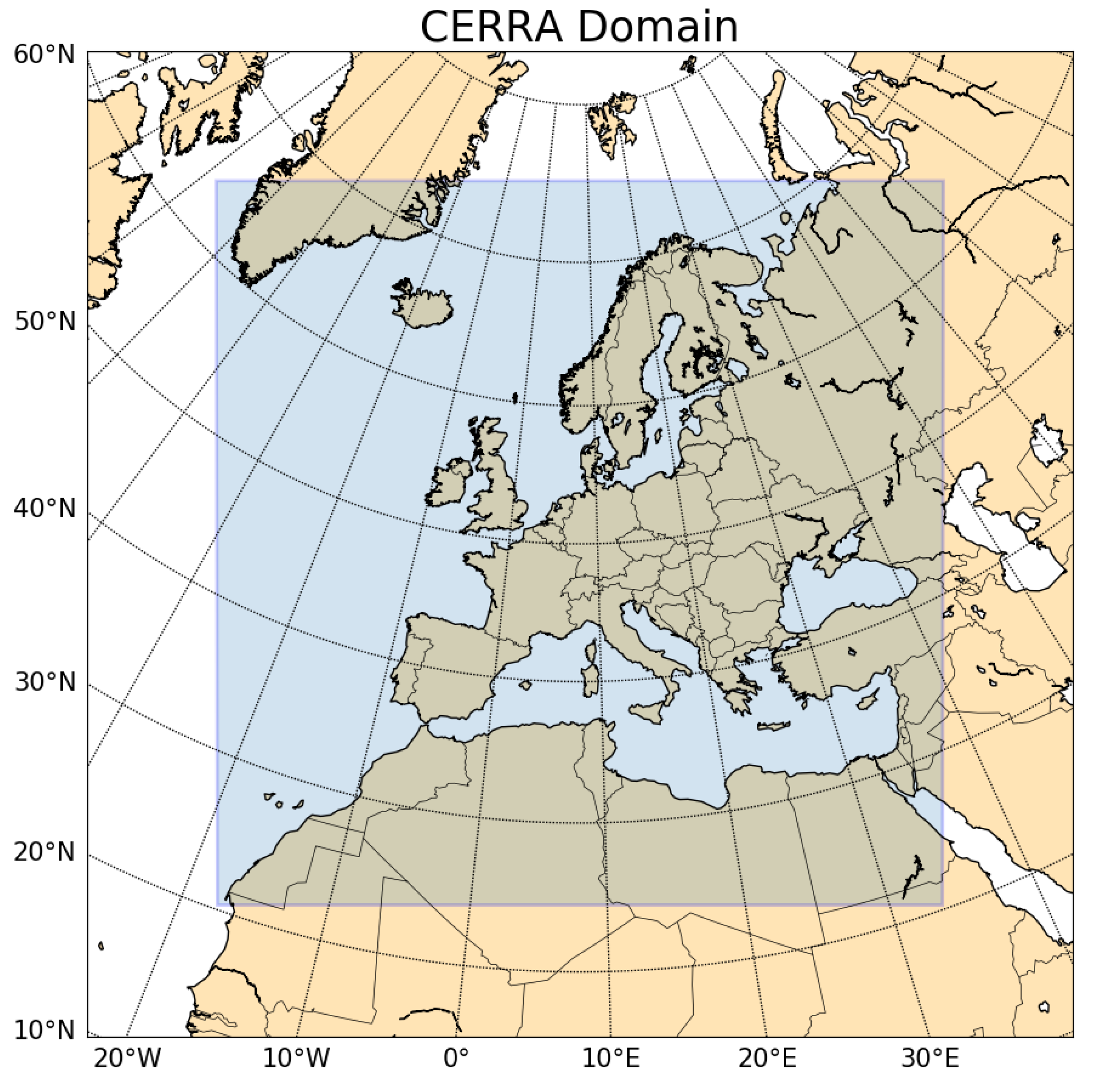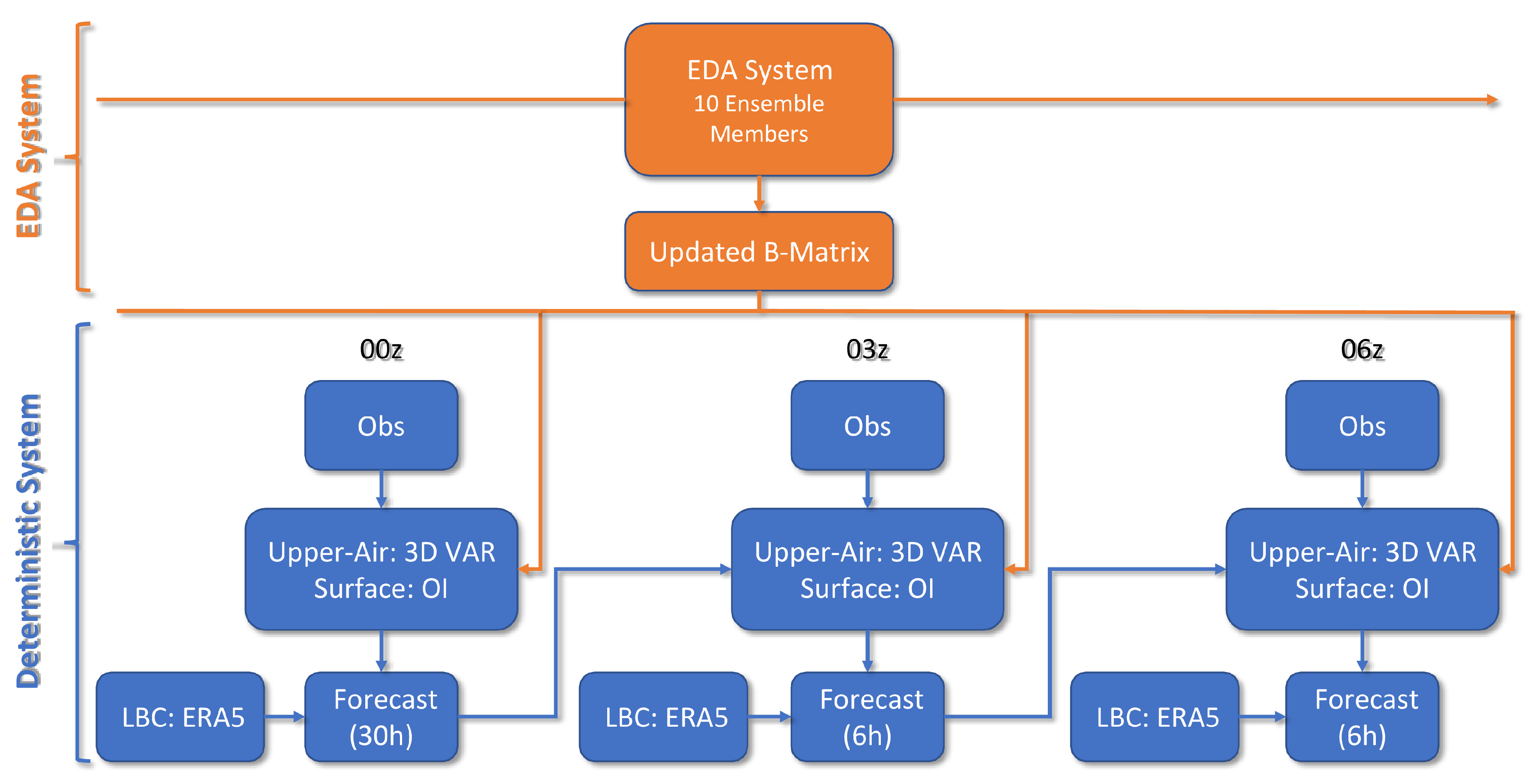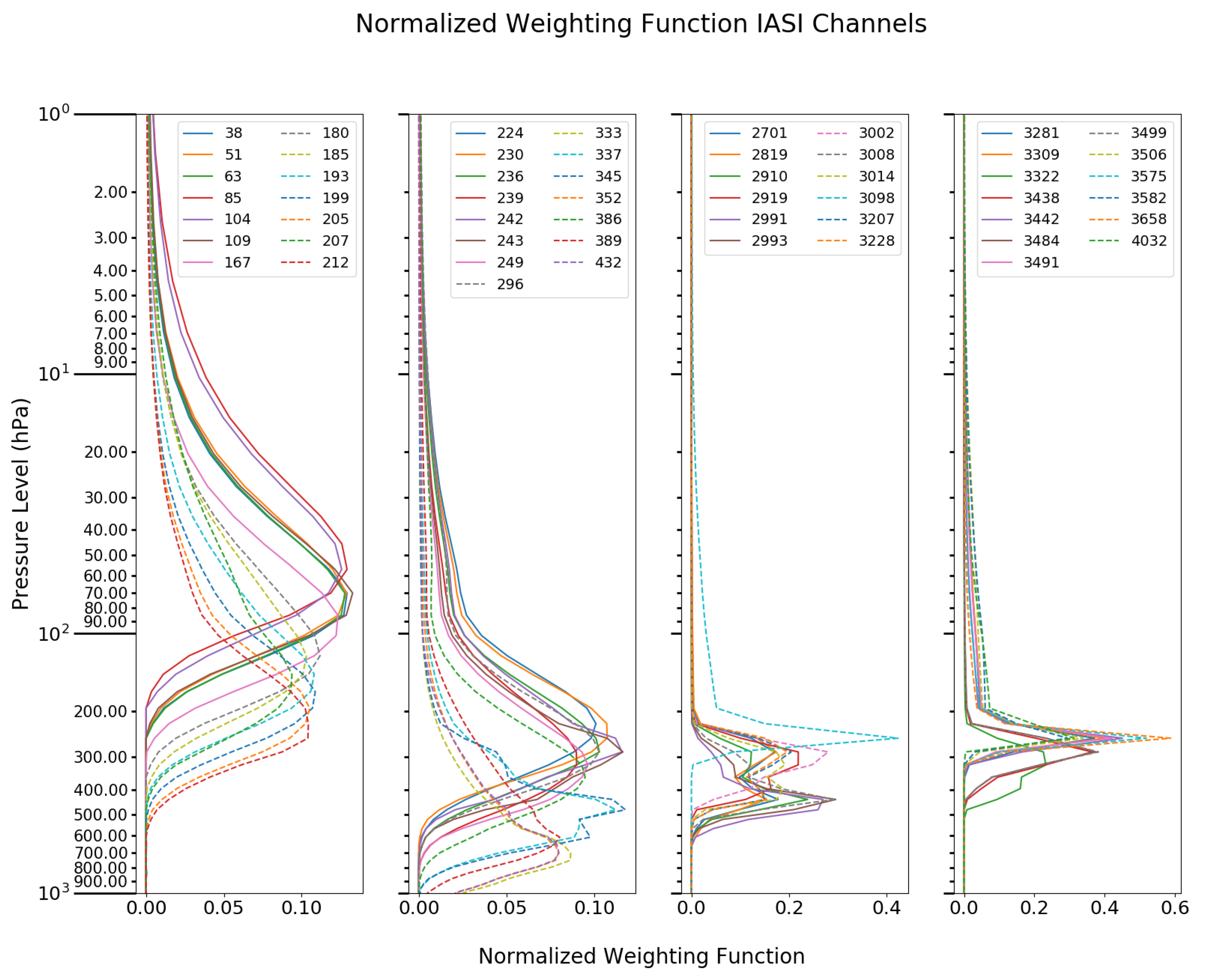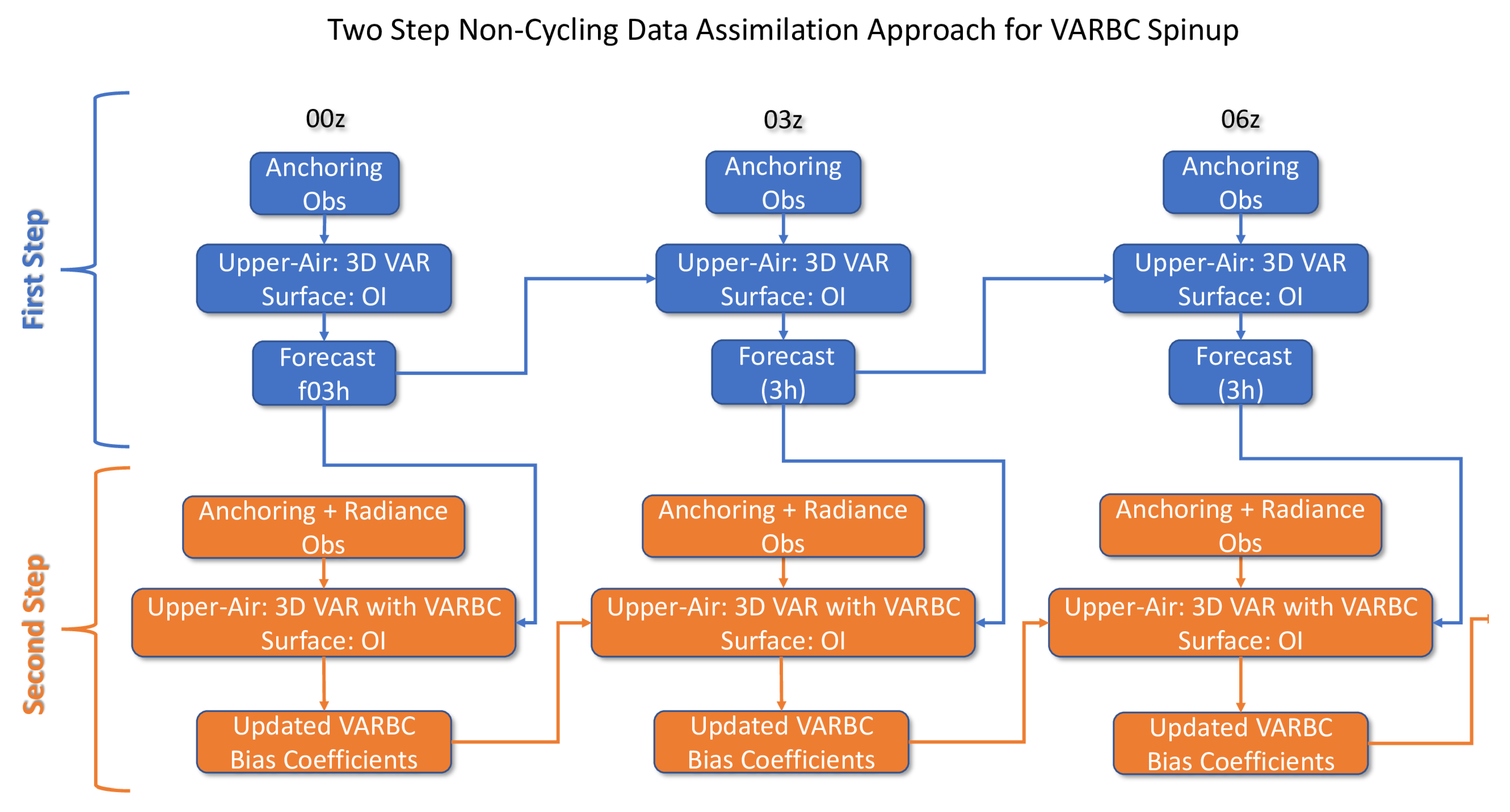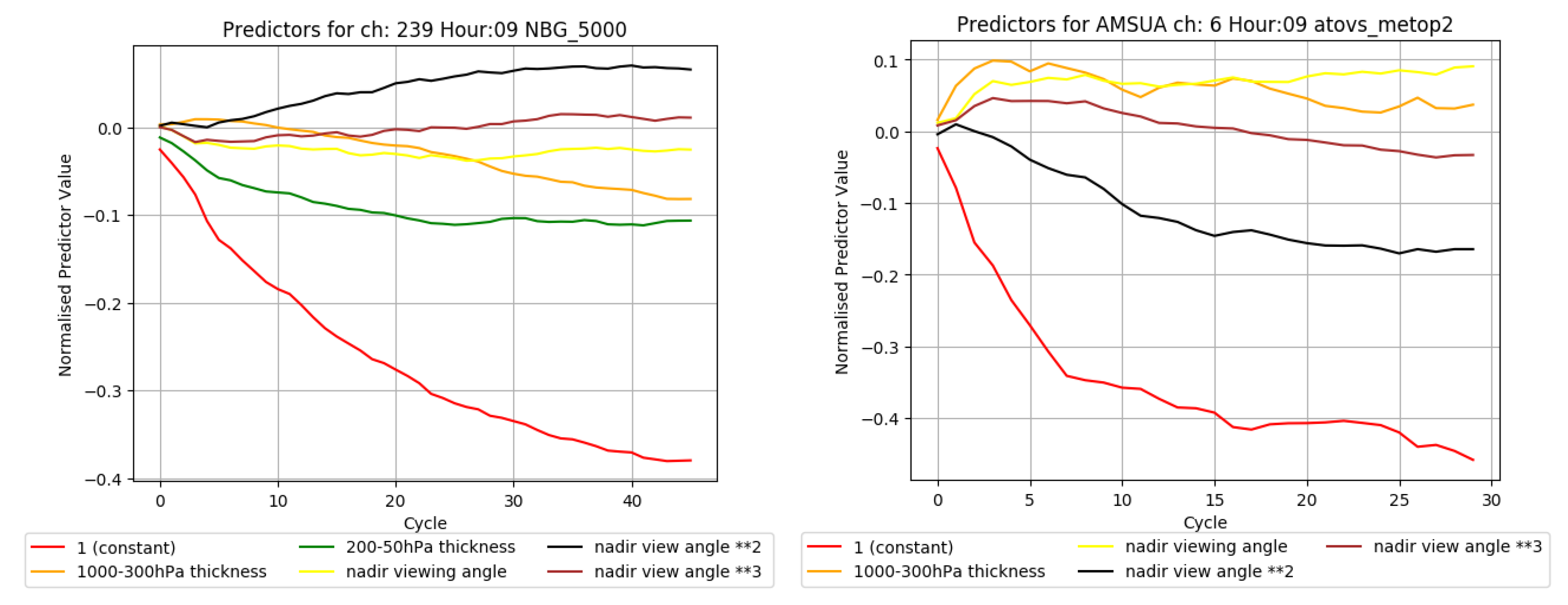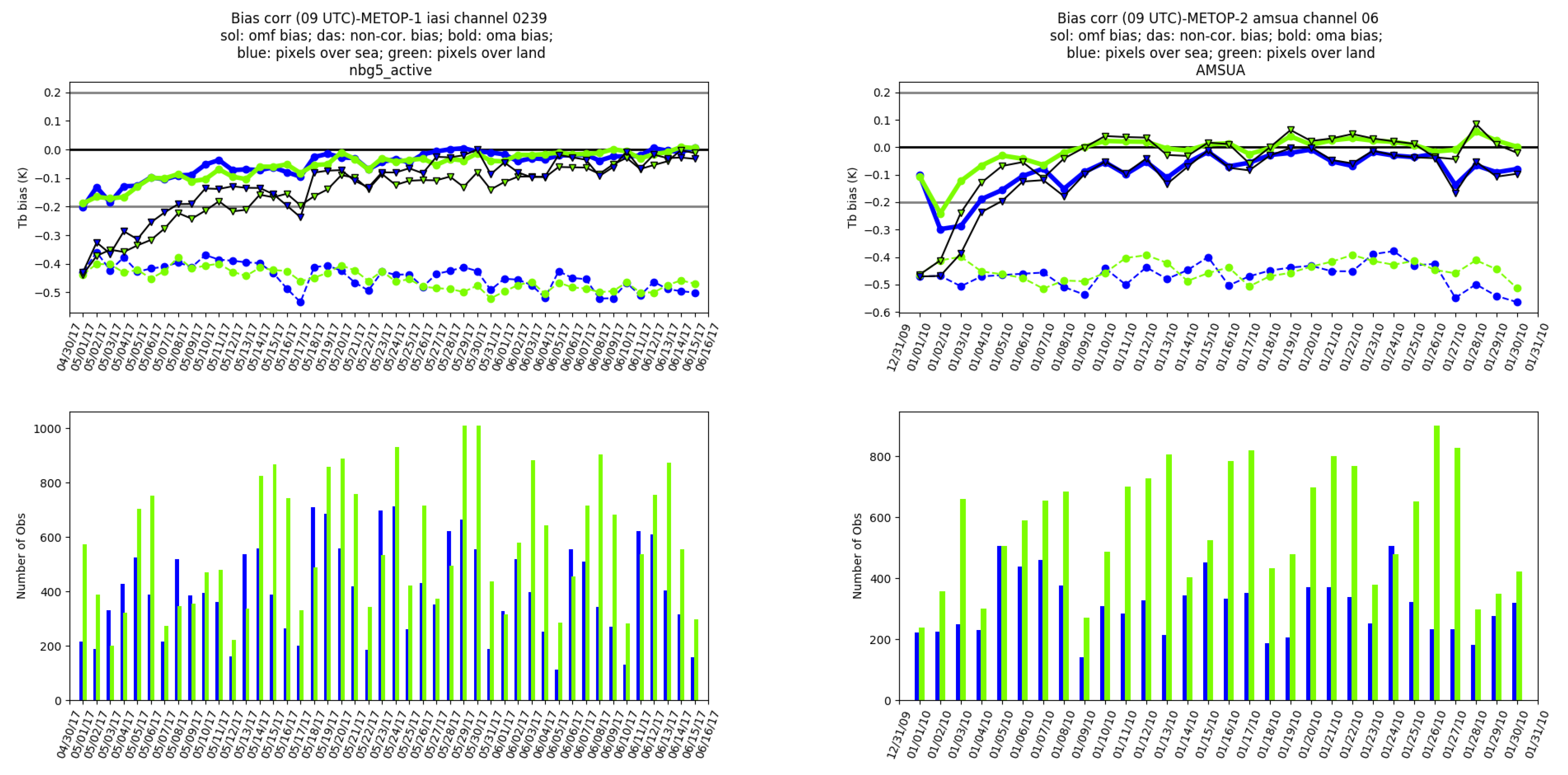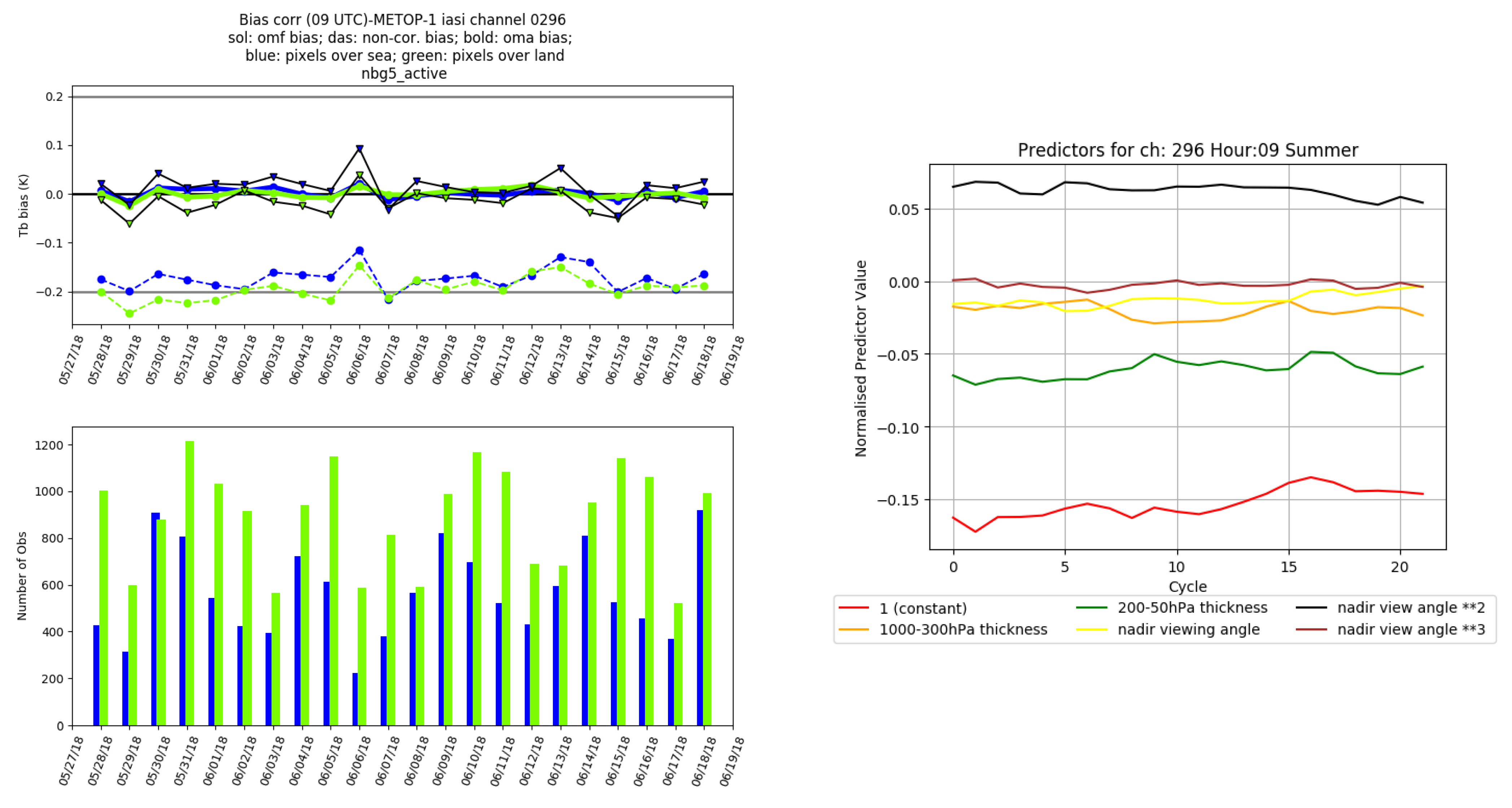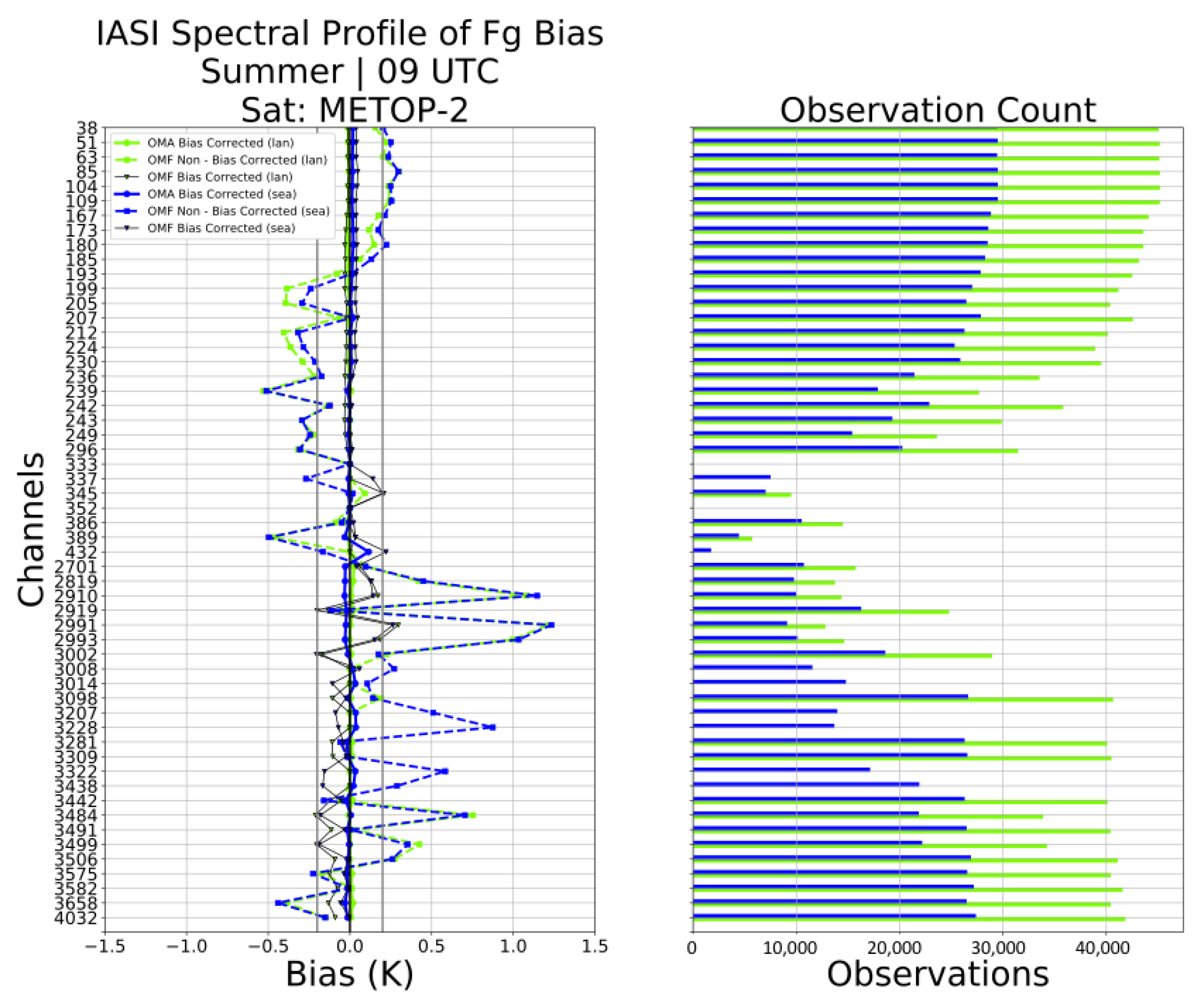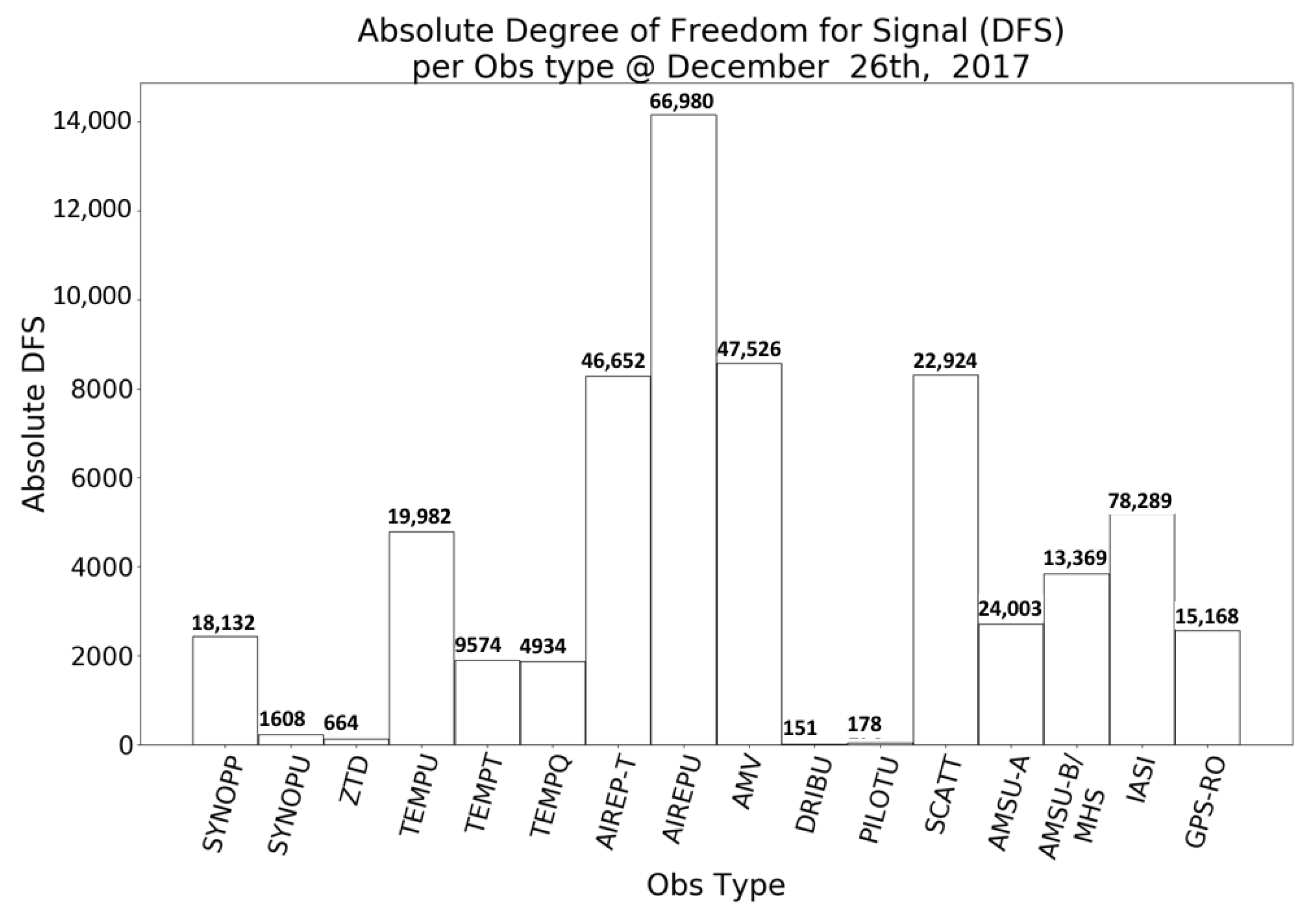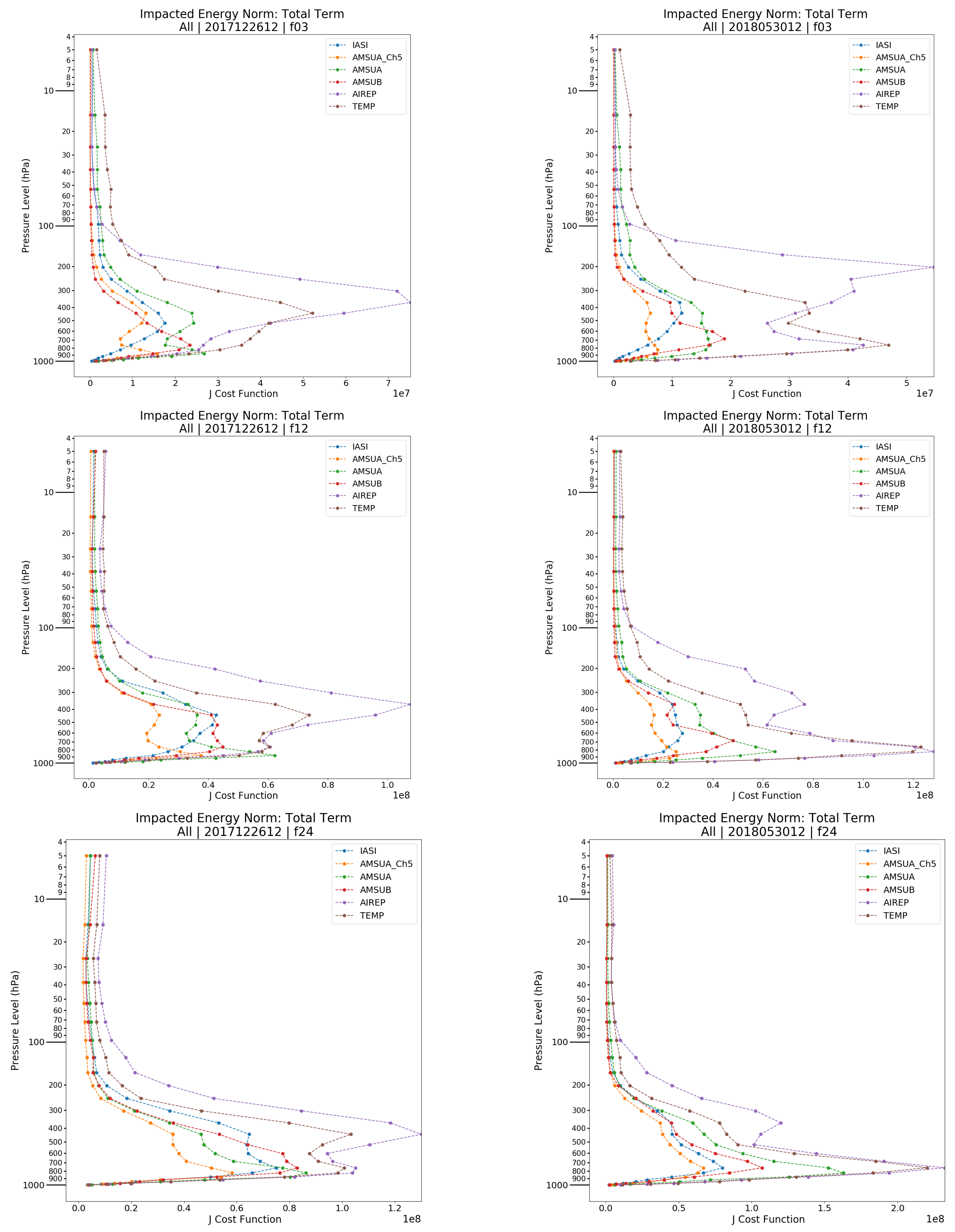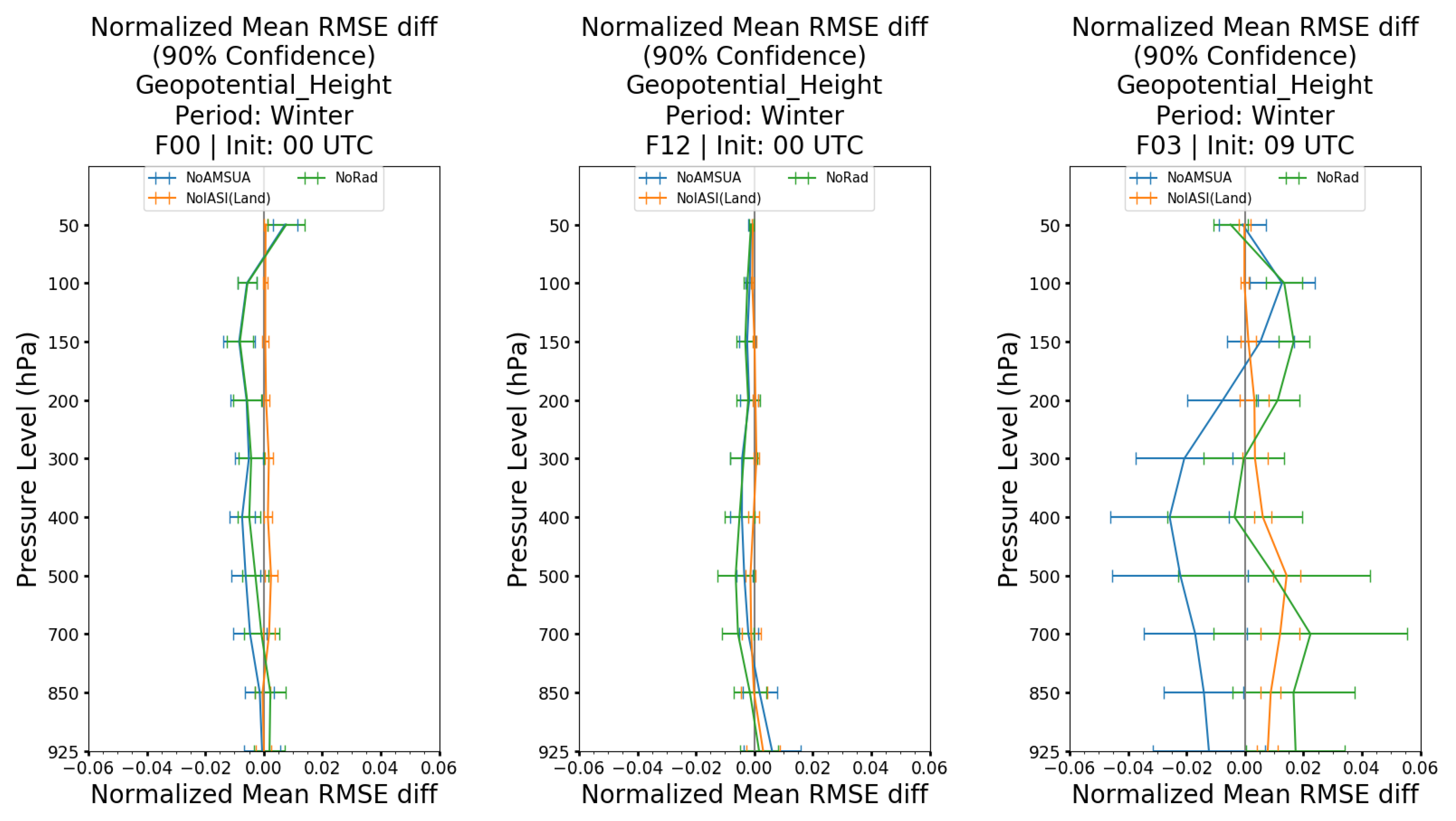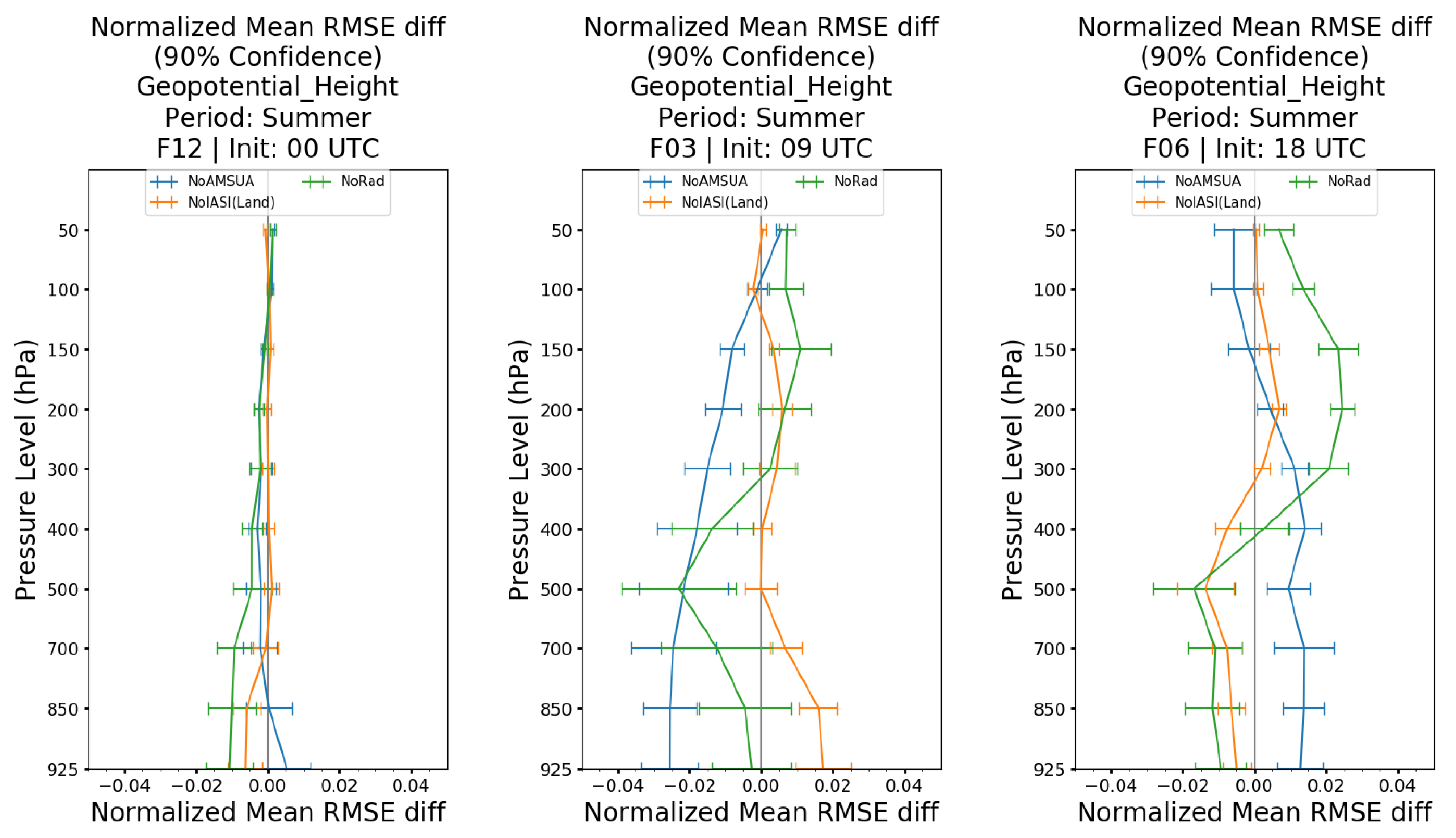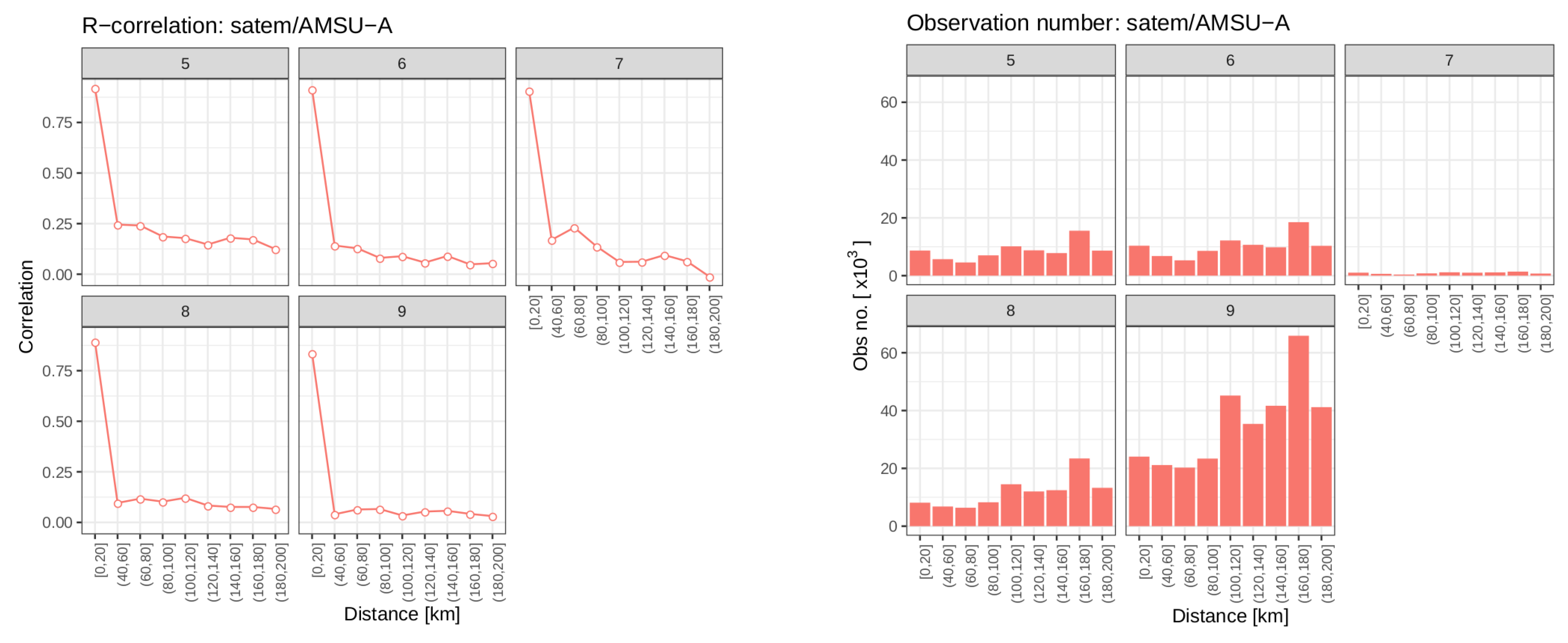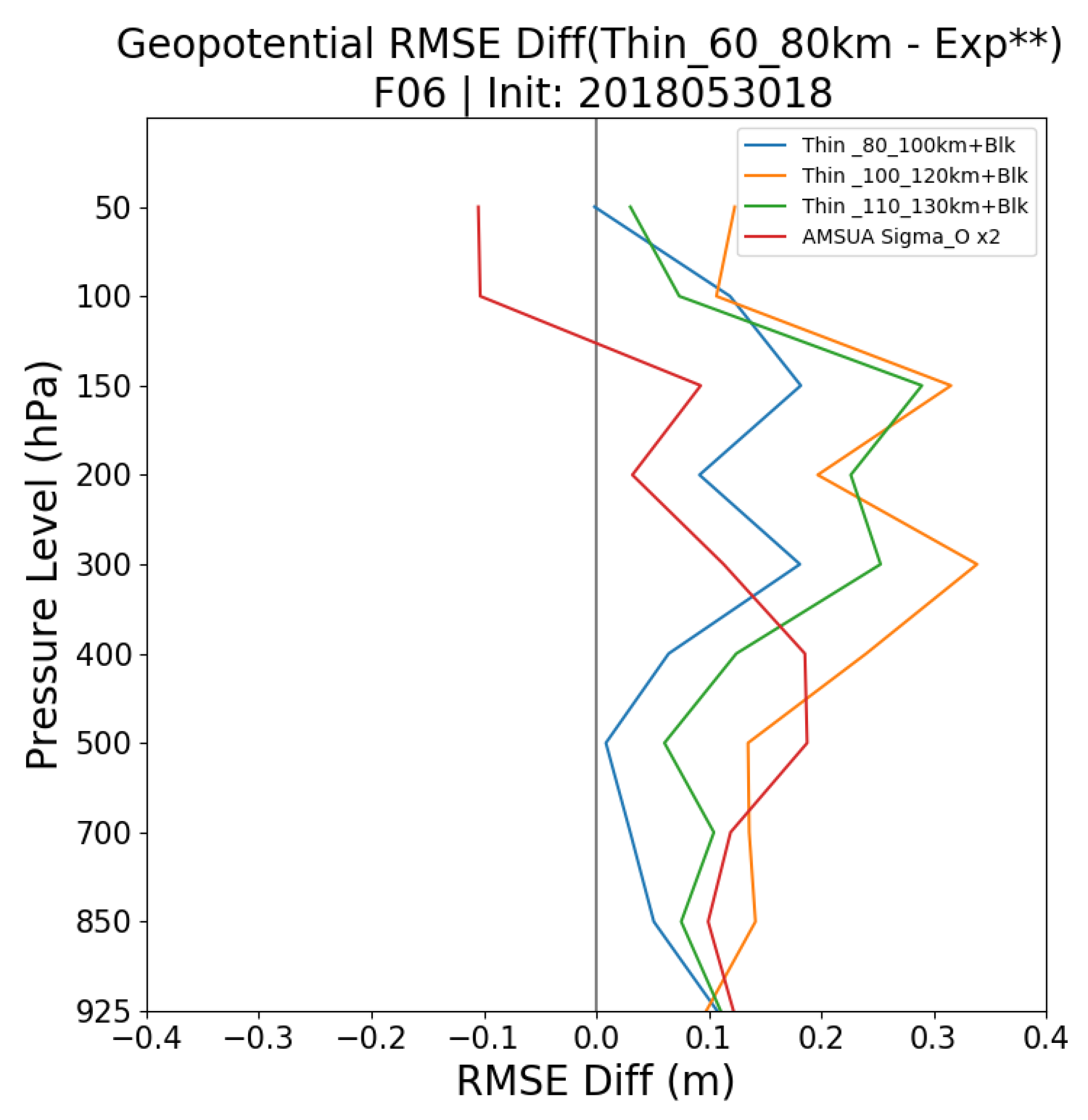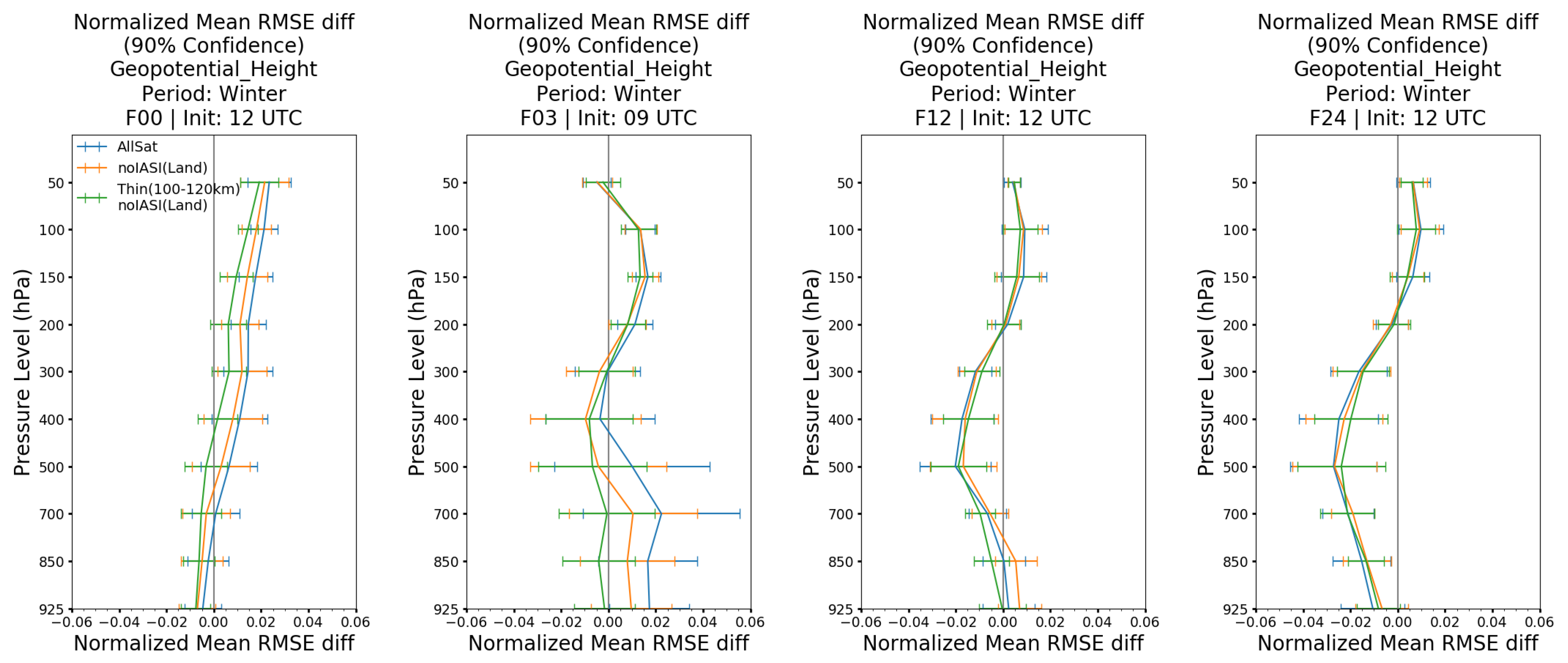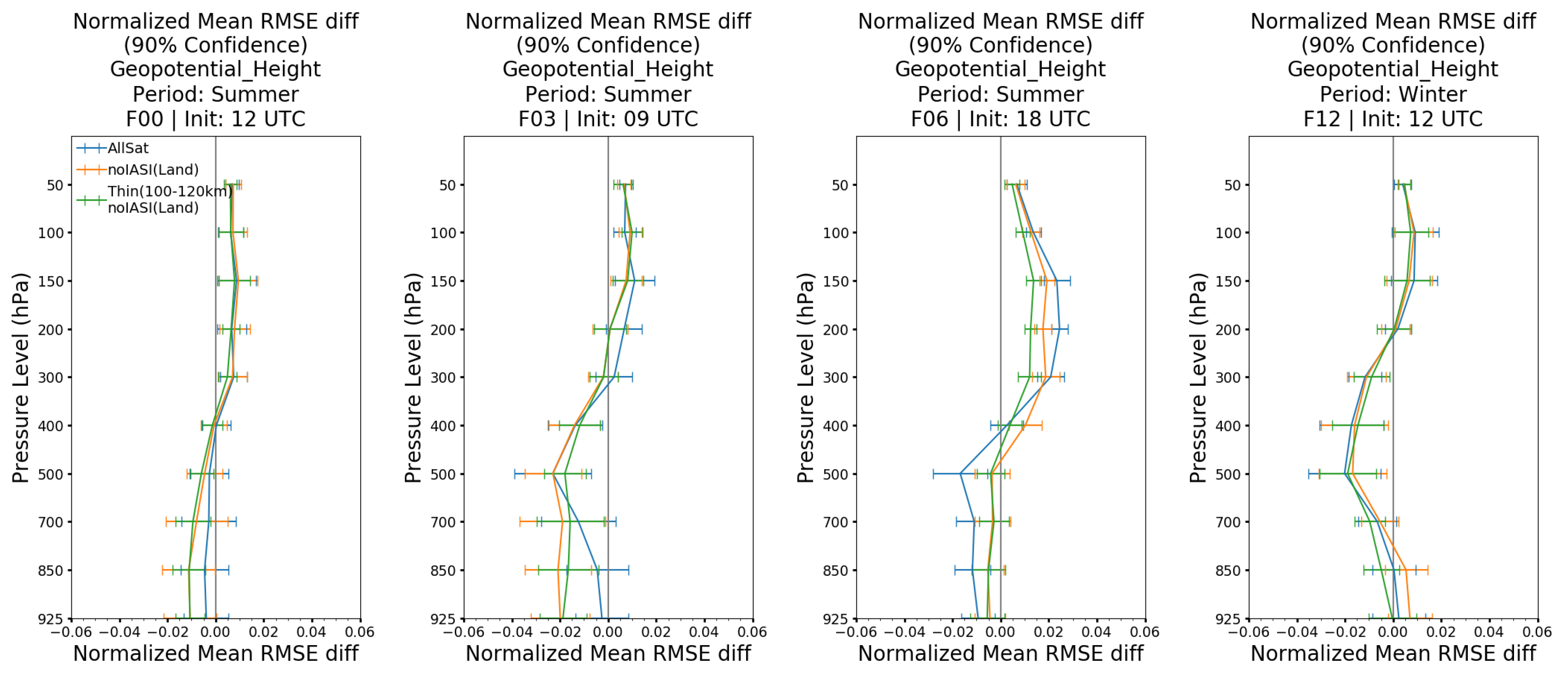1. Introduction
The importance of the reanalysis has expanded over various meteorological and climatological applications over the years, where it can be an effective tool for observing long-term trends in climate monitoring studies, such as climate anomalies and variability [
1,
2]. Within the numerical weather prediction (NWP) community, the reanalysis can be used to study the impact of the changing observing system [
3]. There are also industrial applications, including wind power assessment for potential wind farm establishments [
4]. The reanalysis provides the best estimate of the atmospheric state throughout an extended period in the past from the assimilation of archived observations in an NWP system. A frozen state-of-the-art configuration of the NWP system is used to produce the reanalysis to ensure that any anomaly and trends are associated with the climatological changes rather than from the progressive changes in a typical operational NWP system [
1].
Among the existing reanalysis datasets, ERA-Interim [
5] and the subsequent generation ERA5 [
3] are the most widely used global reanalyses, produced by the European Centre for Medium-Range Weather Forecasts (ECMWF). In order to resolve smaller-scale processes, the Uncertainty in Ensemble of Regional Reanalysis (UERRA) Project of the seventh framework programme (FP7) offers a high-resolution regional reanalysis over Europe. The UERRA reanalysis is based on the Harmonie regional NWP system, developed by the HIRLAM (High-Resolution Limited Area Model) consortium with the ALADIN (Aire Limitée Adaptation Dynamique Développement International) physics [
6,
7]. It has an 11 km horizontal resolution with 65 vertical levels while using an optimal interpolation (OI) assimilation scheme for surface analysis and three-dimensional variational (3D-VAR) data assimilation for upper-air analysis. Unlike the global reanalysis systems mentioned above, UERRA reanalysis does not assimilate satellite radiance observations and any other non-conventional upper-air observations.
A subsequent service project funded by the Copernicus Climate Change Services (C3S) delivered an extended near-real-time UERRA reanalysis dataset, up to July 2019. In parallel, a new modernized reanalysis system called Copernicus Regional Reanalysis for Europe (CERRA) was developed and currently in production for the period between the early 1980s to near real-time. The project was led by the Swedish Meteorological and Hydrological Institute (SMHI), in collaboration with the Norwegian Meteorological Institute (MET Norway) and Meteo-France. The CERRA dataset will be continuously updated throughout the production period and available in the Copernicus Climate Data Store (
https://cds.climate.copernicus.eu/#!/home).
Similar to the UERRA system, the CERRA reanalysis system is based on the Harmonie NWP system with ALADIN physics, OI for surface analysis and 3D-VAR for upper-air analysis [
8,
9]. However, it has a higher horizontal and vertical resolution of 5.5 km and 106 levels, respectively. Additional improvements to the CERRA system include an Ensemble Data Assimilation (EDA) system coupled with the deterministic CERRA system to regularly update the flow-dependent information in the background error covariance matrix (B-Matrix), used in the 3D-VAR deterministic system [
10,
11]. The flow-dependency updates in B-Matrix were intended to better represent the evolving errors associated with passing/changing weather systems, which can lead to producing more representative analyses and forecasts [
12]. Lastly, the CERRA system aims to assimilate additional observations from the observing system, such as satellite radiance observations and other non-conventional observations. It is anticipated that the increase in observations will produce a more accurate representation of the atmospheric conditions.
The assimilation of radiance observations has shown improvement in NWP’s forecast skills [
13,
14,
15,
16,
17], especially over the sea where conventional observations are sparse. These observations also have a higher temporal and spatial resolution while covering over an extensive area in a given assimilation window. However, the assimilation of radiance observations is not trivial, where handling radiance bias correction and observation error correlation can be a challenge. Many NWP centres have adopted variational bias correction (VARBC) to reduce the radiance bias associated with instrumental, calibration and systematic errors in the radiative transfer model [
18,
19,
20]. In addition, various diagnostic tools and methods are available to determine the acceptable spatial and inter-channel observation error correlation [
21,
22,
23] to appropriately assimilate radiance observations.
This paper describes the development and impact of assimilating radiance observations in the CERRA system. The configuration of the NWP system and the radiance assimilation setup is discussed in
Section 2 and
Section 3, respectively. The impact of the variational bias correction is studied in
Section 4. The relative impact of the radiance observations on the data assimilation and forecast systems is examined using two diagnostic metrics in
Section 5, while the impact of the satellite radiances is examined through verification against conventional observations during both summer and winter periods in
Section 6. Lastly, the discussions and conclusions are presented in
Section 7.
2. NWP Configuration
The CERRA system is developed under the framework of the HARMONIE version 40h.1.1 [
24], with ALADIN physic and hydrostatic dynamic schemes [
7]. It has a 5.5 km horizontal resolution with 106 vertical levels, spanning up to the model top of 1 hPa. The domain of CERRA covers Europe, Northern Africa and South-Eastern parts of Greenland, as shown in
Figure 1.
The NWP is initialized with a 3D-VAR assimilation scheme for the upper air and an OI for the surface assimilation. The upper air analysis is computed through the minimization of the 3D-VAR cost function J, shown in Equation (
1):
where
is the background model state,
is the observation vector,
H is the observation operator and
and
are the background and observation error covariance matrices, respectively. The NWP system has a 3-hourly cycling interval, where 30 h forecasts are produced at 00 and 12z assimilation times (cycles) and up to 6 h forecasts are generated at the 03, 09, 15 and 21z assimilation times. Unlike in the operational NWP systems, the number of observations assimilated in a reanalysis system is not limited by the observation cut-off time, since reanalysis is produced in hindsight relative to the time of observation measurement. Effectively, it has a longer assimilation window, which enables the assimilation of all observations measured within the 3-h assimilation window, including the reprocessed observation datasets.
An EDA system is coupled with the CERRA system to regularly update the B-Matrix, which is used in the deterministic 3D-VAR assimilation system. The B-Matrix consists of the climatological and the Ensemble Flow dependent (EFD) components, calculated from the EDA’s forecast differences [
10]. The EDA system comprises 10 ensemble members, with 11 km horizontal resolution and has a 6 hourly cycling interval. Due to the different horizontal resolutions between the EDA and the deterministic system, the forecast differences were downscaled to the deterministic system’s 5.5 km resolution before being used to update the B-Matrix. Both systems use the ERA5 reanalysis as the lateral boundary conditions and assimilate the same types of observations. A workflow diagram in
Figure 2 summarizes CERRA’s coupled systems.
An important focus during the development of the CERRA system was to assimilate as many observations that are available from the observing system throughout the reanalysis period. This was a challenging task as all the selected observation types from the 1980s to near-present have to be appropriately assimilated in the CERRA system.
Table 1 shows the conventional observations that were chosen to be assimilated in the CERRA system, including local surface observations that are collected and quality controlled at the meteorological agencies in the Nordic countries (Norwegian Meteorological Institute (MET Norway), Danish Meteorological Institute (DMI), Swedish Meteorological and Hydrological Institute (SHMI), Finnish Meteorological Institute (FMI), Icelandic Meteorological Office (IMO)) and Météo France. Subsequently, the satellite observations selected to be assimilated are summarized in
Table 2. It consists of the Microwave Sounding Unit (MSU), Advanced Microwave Sounding Unit-A and B (AMSU-A and AMSU-B), Microwave Humidity Sounder (MHS), Infrared Atmospheric Sounding Interferometer (IASI), Atmospheric Motion Vectors (AMV), GPS Radio Occultation (GPS-RO) and Ground-Based GNSS Zenith Total Delay (ZTD). The processing of the satellite radiance observations will be discussed more in detail in
Section 3.
4. Impact of Variational Bias Correction
The VARBC coefficients were effectively spun up by adopting the two-step data assimilation approach.
Figure 5 (left) illustrates the progression of the bias correction predictor coefficients during the 47-day VARBC spin up period for IASI channel 239 (704.50 cm
) on MetOp-B at the 09 UTC cycle. This plot shows that the bias correction coefficients for most of the predictors have converged to stable values after approximately 43 days. In addition,
Figure 6 (top-left) shows the evolution of the bias correction for the same channel over land and sea. The result reveals that observation minus first-guess (OMF) and observation minus analysis (OMA) biases slowly decrease towards 0 K from −0.43 and −0.2 K, respectively. After 43 days, the OMF and OMA biases have reduced to near-zero, which is consistent with the convergence of the bias correction predictor coefficients seen in
Figure 5 (left). On the other hand, the non-corrected bias of OMF maintained approximately the same values, as expected. Similar results in
Figure 5 (right) show the convergence of bias correction predictor coefficients for AMSU-A channel 6 (
GHz) on MetOp-A after 15 days. Furthermore, the bias comparison in
Figure 6 (top-right) indicates the OMF and OMA are reduced below 0.1K with the same period from −0.5 and −0.3 K, respectively. Overall, the two-step data assimilation procedure for the VARBC coefficients spin-up has been demonstrated to be effective in stabilizing the gradual reduction of the biases from the radiance observations and iteratively refining the bias coefficients during the spin-up period. Comparable results were found for the other IASI, AMSU-A, and AMSU-B/MHS channels.
Once the bias coefficients from the VARBC spin-up period are considered to be representative of the biases associated with the assimilated radiance observations, it can be used in the full NWP system. Unlike the VARBC spin-up procedures, the first guess in the operational CERRA system is cycled in the subsequent assimilation time, as described in
Figure 2. A 21-day experiment with the full CERRA system was conducted to examine the performance of the VARBC scheme and the impact of the radiance assimilation.
Figure 7 (top-left) illustrates the time series of non-corrected OMF bias, corrected OMF bias and OMA bias for IASI channel 296 (718.75 cm
) on MetOp-B at the 9 UTC cycle. This result shows a reduction between the non-corrected OMF biases and the corrected OMF bias, decreasing from 0.2 K to less than 0.1 K. One can also see that the biases are relatively stable and have minimal fluctuation throughout the period of the experiment. This result is consistent with relatively stable bias predictor coefficients found in
Figure 7 (right). Overall, these findings suggest that the VARBC coefficients that were computed during the spin-up period can be effectively used in the full NWP system for a long-term experiment and production of the CERRA dataset. Similar results were found for AMSUA, AMSU-B and MHS instruments.
In order to have a more comprehensive approach to analyze the bias for all of the 55 assimilated IASI channels,
Figure 8 shows the spectral profile of the non-corrected OMF bias, corrected OMF bias and OMA bias for all of the selected IASI channels on MetOp-A at 9 UTC assimilation time. Generally, the channels with relatively high peaking weighting functions from CO
absorption bands (Channel 38 to 193; 654.25 to 693.00 cm
) have non-corrected OMF biases between 0.2 to 0.5 K. The lower peaking channels (Channel 199–432; 694.50 to 752.75 cm
) have smaller non-corrected OMF biases, fluctuating close to 0.2 K. Lastly, the respective values for the channels in the water absorption bands (Channel 2701–4032; 1320.00 to 1652.75 cm
) are as high as 1.2 K. As expected, the corrected OMF and OMA biases for channels from CO
absorption bands are systematically close to zero. However, few channels in the water absorption band have higher bias-corrected OMF, reaching up to 2.3 K. Due to this high bias-corrected OMF bias, the observation errors were configured to be greater compared to the other absorption bands to reduce the impact on the analyses and forecasts [
39]. Similar results are also seen for other cycles that assimilate IASI observations.
6. Impact of Radiance Observations through Verification Scores
As previously mentioned, DFS and MTEN diagnostic metrics provide the relative impact of the radiance observations on analysis and forecast, but it does not provide information on the quality of the impact (positive or negative). Consequently, the impact from a subset of observations can be further assessed by performing data denial Observing System Experiments (OSEs), where the observations of interest are removed from the full assimilation system [
39,
45,
46,
47]. The produced analyses and forecasts (impact experiments) are then compared with their counterpart from the full (control) assimilation system to assess the changes in the analyses and forecasts through verification scores. It is essential to ensure that the difference in the quality of the analysis and forecast between the control and the impact experiments are significant and not attributed to the chaotic variability in the atmosphere. This issue becomes more critical for regional NWP systems and with relatively shorter experiment periods because of the fewer available observation samplings used in the verification. Based on the Student’s T-test, significant tests are used to compute the normalized mean root mean square error (RMSE) difference, where the temporal auto-correlation is corrected using the first-order auto-regressive process, as discussed in [
48] and used by [
17,
20]. It is worth noting that the significance of the statistical results are only valid for the relatively short duration of the experimental period, within the larger reanalysis period. The verifications focus on the changes in the atmospheric part of the CERRA analyses and forecasts, which verifies the analyses and forecasts against radiosonde observations at 00 and 12 UTC, while providing insight on the significance of the results.
The first OSE (“
NoRAD”) was conducted to assess the impact of all radiance observations by removing them from the full assimilation system. The verification scores of the analyses and forecasts were then compared against the control experiment (“
Allsat”), which consisted of an assimilation system with all radiance observations. The experiments were performed for both the summer and winter periods, spanning from 23 December 2017 to 16 January 2018 and 28 May to 19 June 2018, respectively. In addition, an eight days model warm-up period was applied to all the experiments, prior to the verification periods.
Figure 11 and
Figure 12 illustrate the vertical profile of the normalized mean RMSE Difference at 90% confidence for geopotential height between “
AllSat” and “
NoRAD” for the summer and winter periods, respectively. Negative values in the figures indicate the normalized mean RMSE for “
AllSat” experiment is less than that of the impact experiment, suggesting the errors of the forecast or analysis is reduced when the subset of observations is included in the full assimilation system. In other words, it can also be interpreted as the deterioration of the analysis and forecast caused by removing the subset of observations from the full system, indicating that the subset of observations has a positive impact. This study focuses on the impact on Geopotential height because of the high statistical significance across many of the analysis times and forecast lengths. Such high statistical significant results are not as distinct for the other verified variables.
From the winter period in
Figure 11, the assimilation of all radiance observations (green line) has minimal impact on the analyses (left and middle plots), while increasing the normalized mean RMSE by 1–2% between 200–100 hPa and below 500 hPa on the 3-h forecasts from 09 UTC (right plot). On the other hand, the 24-h forecast from 12 UTC has an error reduction by 1.5 to 2.5% below 300 hPA, while the neutral impact is observed above 200 hPa (not shown). The summer case in
Figure 12 illustrates a minimal impact on the analyses at 12 UTC. There is a positive impact on the 3-h forecasts from 09 UTC below 400 hPa with 2% reduction in RMSE reduction with significance at 500 hPa, although 1% significant degradation is also observed between 150 and 50 hPa. In addition, the impact on the 6-h forecasts from the 18 UTC cycle shows a significant improvement of 1% below 500 hPa, but a negative impact up to 2% for 300 hPa and above. Such negative impact in the upper troposphere and stratosphere is not observed on the other forecast lengths and assimilation times, which prompted further examination to determine the cause of this phenomenon.
In the initial investigation, several one-day OSEs were conducted for AMSU-A, AMSUB/MHS and IASI for both the summer and winter periods. A comparison of the geopotential height forecast fields at various vertical levels showed that AMSU-A and IASI had the strongest impact, while minimal influence was observed from AMSUB/MHS (not shown). From the short experiments, the assimilation of AMUS-A typically has a positive impact when verified against radiosonde observations, while the impact of IASI was inconclusive. This indistinctive impact from IASI may be contributed by the CERRA system’s inability to characterize skin temperature and emissivity for the assimilation surface-sensitive IASI channels over land. ECMWF’s global NWP system had similar constraints, resulting in rejecting all IASI observations over land in their assimilation system [
49]. This issue in the CERRA system was initially addressed by rejecting predominant surface-sensitive channels, but a few relatively low peaking channels are still assimilated, which can lead to additional uncertainties into the system. Due to the shortened experiments, the results can be questionable without insight on its significance.
In order to substantiate this hypothesis in a robust manner with significance, two additional 21+ days OSEs were performed for AMSU-A (“
NoAMSUA”) and IASI observations over land (“
NoIASI(Land)”) for the summer and winter periods. Similar to “
NoRad” comparison, the vertical profiles of the normalized geopotential height mean RMSE difference at 90% confidence for “
AllSat” minus “
NoAMSUA” and “
AllSat” minus “
NoIASI(Land)” are shown in
Figure 11 (Winter) and
Figure 12 (Summer). In the winter case (
Figure 11), the assimilation of AMSU-A reduced the error by 0.5 to 1% with significance on the analyses at 00 and 12 UTC (left and middle plots). Furthermore, there is also an error reduction of 1.5 to 2% at 400 and 300 hPa on the 3-h forecasts from 09 UTC (right plot). However, the assimilation of IASI observation over land increased the error by 0.5 to 1.5% for the 3-h forecasts, initialized at 09 UTC. The results in the summer case (
Figure 12) indicate that the assimilation of AMSU-A reduced the error of the analyses at 12 UTC by 1 to 1.5% for pressure levels between 925 to 500 hPa (left plot). The error reduction is also seen below 150 hPa for the 3-h forecast from 09 UTC by 1 to 2.5% (middle plot). Furthermore, the assimilation of IASI over land increased the error by 0.5 to 1.8% of the analysis at 00 UTC (not shown) and of that of 3-h forecasts from 09 UTC (middle plot). The results from the 6-h forecasts, initialized at 18 UTC showed an improvement in the error of 0.5 to 1% for pressure levels between 300 and 925 hPa but deteriorated the forecast at 200 and 100 hPa (right plot).
In the summer case, the negative impacts on 6-h forecasts from 18 UTC cycle are highly correlated between “NoRad” and “NoIASI(Land)” experiments within the upper troposphere and the stratosphere. By rejecting the IASI observations over land, the negative impact in the upper levels is slightly reduced, although the observed positive impact in the lower troposphere also reduced well. Further, we also observed that the positive impacts on other forecast lengths and assimilation times are enlarged. Overall, the results suggest that the rejection of IASI observations over land improves the accuracy of the analyses and forecasts. However, the residual negative impact is still present for the upper troposphere and stratosphere in the case of 6-h forecasts from 18 UTC.
Further investigations were conducted to determine the cause of the upper level negative impact from assimilating all radiance observations for the 6-h forecast at 18 UTC, during the summer period. Among various possibilities, the radiance observation error correlation and the configuration of the thinning distance for radiance assimilation were examined. One can use a method proposed by [
21] (referred to as the Desroziers method hereafter) to derive the spatial correlation of observation errors, which is computed based on the observation and analysis departures in observation space. This approach was used during the development of the CERRA system to study the appropriate thinning distance for the assimilation of ATOVS and IASI observations. Based on Desroziers method,
Figure 13 illustrates the observation error correlation against the spatial separation distance for AMSU-A channels 5–9 (
GHz). The results for channels 6, 8 and 9 (54.40, 57.290 and
GHz) suggest that the correlation of observation error has reached lower than the threshold of 0.2. This value of the threshold for an optimal thinning distance was suggested by [
23]. However, the correlation for channel 5 (
GHz) remains to be greater than this threshold for the separation distances less than between 80 and 100 km. This is also seen from [
22], where channel 5 (
GHz) has a relatively higher correlation due to its sensitivity to the surface. Lastly, channel 7 (
GHz) has a less conclusive result as the correlation fluctuates over the threshold from a distance of 40 to 100 km, which can be attributed to the significantly fewer number of observations used in the computation, compared with that of the other channels. Furthermore, the AMSU-B/MHS comparison suggests that the observation error correlation for channel 4 (
GHz) remains slightly above 0.2 from 40–60 km (not shown). Similarly, few IASI channels in moisture absorption bands and high peaking CO
absorption bands are highly correlated (0.25 to 0.35) for separation distances greater than 120–200 km, including channels 104, 180, 2991, 3098, 3309 and 3506 (
and 1521.25 cm
−1) (not shown). Overall, the results suggest that the currently prescribed thinning distance parameters for the assimilation of radiance observations might not be appropriate and therefore further tuning is needed.
In order to address the high observation error correlation for radiance observations in the CERRA system, one can increase the thinning distance and/or inflate the observation error for these observations [
22,
50]. Consequently, three impact experiments with different thinning distance configurations for radiance observations were conducted, while rejecting IASI channels 104, 180, 2991, 3098, 3309 and 3506, due to its highly correlated observation errors. An additional impact experiment (“
AMSUA Sigma_O x2”) was performed with the default thinning distance setting, but inflating the observations errors for AMSU-A observations by a factor of two. Lastly, a control experiment (
Thin_60_80 km) with the default configuration described in
Table 4 was conducted. A summary of the five experiments with different configurations is shown in
Table 6.
The five experiments were conducted to produce the single-cycle 6-h forecast from 18 UTC 30 May 2018 to further address the negative impact of all radiance observations on the upper troposphere and the stratosphere. This investigation is limited to a single forecast cycle due to the limited computation resources.
Figure 14 depicts a vertical profile of geopotential height RMSE difference between the control experiment (“
Thin_60_80 km”) and the (four) impact experiments for the 6-h forecast, initialized at 18 UTC on 30 May 2018. The forecasts are verified against radiosonde observations. Positive values indicate that the control experiment with the default settings has larger RMSE than the impact experiments, suggesting that the impact experiments with the new setting improve the forecast’s accuracy. The results show all three impact experiments with increased thinning distances have lower RMSE than the control experiment, especially for the upper troposphere. Specifically, the “
Thin_100_120 km + Blk” experiment has the lowest RMSE (largest difference compared to the control), while further increasing the thinning distance in the “
Thin_110_130 km + Blk” experiment did not result in an additional RMSE reduction. Lastly, inflating the observation errors for AMSU-A radiance observations by two times in the “
AMSUA Sigma_O x2” experiment reduced the forecast error to the level of that of the “
Thin_100_120 km + Blk” experiment below 500 hPa. However, the reduction in forecast errors was significantly reduced for atmosphere aloft. One should consider these findings with caution since the results have minimal significance when only a single cycle was used in this investigation. Therefore, longer impact experiments with increased thinning distance are discussed in later sections, where the “
Thin_100_120 km + Blk” experiment was conducted for a longer period during both the summer and winter seasons.
The results in
Figure 11,
Figure 12,
Figure 13 and
Figure 14 from the previous discussions suggest that the accuracy of the analyses and forecasts can be further improved by tuning the thinning distance for radiance observations and also by rejecting the IASI observations over land. In order to verify the effects of these modifications, three experiments were conducted and compared against the control experiment (“
NoRad”), where all radiance observations were removed from the full assimilation system. The first impact experiment (“
AllSat”) follows the default setting of the CERRA system, where all observations are assimilated. The second experiment (“
noIASI(Land)”) adopts the same configuration as the “
AllSat” experiment but rejects the IASI observations over land. Lastly, the third impact experiment (“
Thin(100–120 km)_noIASI(Land)”) also follows the configuration from the “
AllSat” experiment, but does not assimilate IASI observations over land and increased the thinning distance for the radiance observation to RMIND_RAD1C = 100 km and RFIND_RAD1C = 120 km.
Figure 15 and
Figure 16 illustrate the vertical profile of the normalized mean Root Mean Square Error Difference (at 90% Confidence) for geopotential height, comparing the impact experiments minus the control experiment using verification against radiosondes. Negative differences indicate a normalized mean RMSE reduction when compared against the control experiment (
NoRad), suggesting that the impact experiments produce more accurate analyses and forecasts compared to the control experiment.
The winter case results in
Figure 15 show that the “
Allsat” experiment provides the smallest normalized mean RMSE reduction against the “
NoRad”, while increases in forecast error were also observed in some cases. On the other hand, “
Thin(100–120 km)_noIASI(Land)” generally has the largest reduction in normalized mean RMSE, followed by “
noIASI(Land)”. Specifically, the 3-h forecast from 09 UTC has an approximately 2% error reduction for “
Thin(100–120 km)_noIASI(Land)” compared to “
AllSat” for pressure levels between 925 to 700 hPa. On the contrary, “
noIASI(Land)” has only roughly 1% error reduction compared to “
AllSat”. Although a more modest error difference is seen for other cases, it is evident that the radiance assimilation setup in “
Thin(100–120 km)_noIASI(Land)” and “
noIASI(Land)” both lead to improved accuracy in analyses and forecasts of geopotential height, compared to “
AllSat”. Nevertheless, “
Thin(100–120 km)_noIASI(Land)” produced the best results for the winter period. The large reduction in normalized mean RMSE from “
Thin(100–120 km)_noIASI(Land)” is less predominant in the summer case, shown in
Figure 16. In particular, there is minimal difference in reduction between “
Thin(100–120 km)_noIASI(Land)” and “
noIASI(Land)”, but both comparisons have up to 1 to 2% normalized mean RMSE reduction compared to “
Allsat” for the analyses at 12 UTC and 3-h forecasts from 03 and 21 UTC cycles. Furthermore, “
Thin(100–120 km)_noIASI(Land)” has the largest error reduction of 1.5% for the 6-h forecasts at 18 UTC above 300 hPa. However, the positive impact for the lower troposphere is slightly reduced compared to “
AllSat”. Lastly, “
Thin(100–120 km)_noIASI(Land)” and “
noIASI(Land)” marginally degrade the 12-h forecast from 12 UTC. Overall, there is an added benefit by rejecting the IASI observation over land and/or increasing the thinning distance for radiance observations, leading to improvements in the accuracy of the analyses and 3-h forecasts.
By establishing “Thin(100–120 km)_noIASI(Land)” as the most optimal assimilation configuration for radiance observations in the CERRA system, one can further evaluate its performance against the control experiment “NoRad”. From the winter case results, the analyses at 12 UTC and the 3-h forecasts from 09 and 21 UTC suggest that “Thin(100–120 km)_noIASI(Land)” have a neutral impact compared to “NoRad” below 200 hPa. However, a positive impact is seen for the 12 and 24-h forecasts, initialized at 12 UTC, where there is a normalized mean RMSE Difference of −1 to −2% for the mid-troposphere. The analysis and 3-h forecast below 400 hPa from 09 and 12 UTC also showed improvement by 0.5 to 1% and 1.5 to 2%, respectively. Similarly, the 12-h forecasts from 12 UTC improved by 1 to 1.5% for 400 and 500 hPa. The negative impact seen from the “AllSat” experiment was reduced by 1% for atmospheric layers above 500 hPa, with the modification of configuration in the “Thin(100–120 km)_noIASI(Land)” experiment. However, the positive impact below 500 hPa in the “AllSat” experiment was reduced by 0.5% from the same changes in configuration.
7. Discussion and Conclusions
This study has considered some of the challenges of satellite radiance assimilation, while demonstrating its impact on the CERRA system. It was discovered that the use of passive assimilation during the VARBC bias coefficient spin-up was not appropriate for high spatial satellite instruments with high-density observation, within the framework of the limited area model. The two-step assimilation alternative approach was able to effectively spin-up the VARBC bias coefficients to be suitable for use in the CERRA production system.
The relative impacts of the satellite radiance observations on the CERRA data assimilation and forecast systems were assessed using DFS and MTEN diagnostic metrics. The results indicate that the conventional observations had the strongest impact on both the analysis and forecasts. However, the difference in impact between the radiance and conventional observations is smaller for the short-range (12 and 24-h) forecasts. In other words, the impact of the radiance observation is more predominant on longer forecast lengths. Similar results have been observed in studies with a similar regional model setup [
41].
The discussion in this paper focused mainly on the impact of radiance observations on geopotential height analyses and forecasts since it has the most distinguishable statistical significance of the impacts compared to that of the other verified variables. This means that less significant impacts of the satellite radiance observations on the other upper-air and surface variables were observed, but not discussed.
The impacts of the satellite radiance observations and their significance were demonstrated through examining the normalized mean RMSE difference of 21+ days OSEs during winter and summer periods. Overall, satellite radiance observations have a neutral impact on the analyses of geopotential height in the lower troposphere, while a slightly negative impact for the upper troposphere and in the stratosphere. Similar neutral impacts were also observed in 3-h forecasts and positive impacts on the 12 and 24-h forecasts (
Figure 15 and
Figure 16). The 6-h forecast at 18 UTC was problematic due to the observed large negative impact above 300 hPa. Further investigation was done to determine the cause of this significant negative impact. The preliminary findings suggest that AMSU-A and IASI have the greatest impact on geopotential, while a weaker impact was seen from AMUS-B/MHS. Additional OSEs were conducted for AMSU-A and IASI observations over land. The results showed that AMSU-A had a neutral impact on the analysis while reducing the errors up to 2.5% for the 3-h forecasts below 300 hPa. On the other hand, IASI observation over land generally increases the errors in the analysis, as well as in the 3 and 6-h forecasts. This can be caused by a lack of consideration of surface emissivity and skin temperature to appropriately assimilate IASI observations over land in the CERRA system. By rejecting this subset of observations, an improvement in the analysis and 3-h forecast accuracy was observed in the upper troposphere. Similar improvement was observed in the stratosphere for the 6-h forecasts from 18 UTC cycle
The Desroziers method applied to the satellite radiance first-guess and analysis departures and verification of OSEs against radiosonde observations that led to the discovery of the radiance assimilation settings in the CERRA system did not appropriately consider the possible observation error correlation for certain assimilated instruments channels. The inflation of observations errors and the increase in the thinning distance were tested in rudimentary verification experiments. The obtained results suggest that increasing the thinning distance (RMIND_RAD1C = 100 km and RFIND_RAD1C = 120 km) and rejecting IASI observations over land yield a considerable error reduction in the forecasts of geopotential heights. These findings are also reflected in a 21+ days OSE in the summer and winter periods, where the errors were reduced up to 2% for the analyses and 3-h forecasts. In addition, the large errors in the upper troposphere and in the stratosphere observed in the 6-h forecasts from 18 UTC were greatly reduced, although the error reduction in the lower troposphere was slightly diminished. Despite this fact, the tested configuration enhanced the CERRA system by improving the accuracy of the analyses and the 3-h forecasts, while keeping the positive impacts on the short-range forecasts (12 and 24 h).
Applying the modified configurations showed that the assimilation of radiance observations improves the accuracy of short range forecasts (12- and 24-h) of geopotential in the lower and mid-troposphere, while neutral to slightly positive impact was observed on the 3-h forecast. Neutral impact was also observed in the tropospheric levels of the analyses, while an increased error was detected for the stratosphere. The increase in error in the analysis, verified against the radiosonde observations does not necessarily indicate the analyses has deteriorated. It is more likely due to the fact that the assimilation of radiance observations causes such a balance between the control variables, which deviates from the observed radiosonde network. This balance seems to represent better the atmospheric state, since the issued forecasts (12 and 24 h) are of significantly better quality.
Overall, the assimilation of radiance observation provides a relatively small, but significant positive impact on the analysis and forecasts in reducing the normalized mean RMSE errors in geopotential heights. Given the short development period of the CERRA system and limited computational resources, it was not feasible to further enhance the assimilation of the radiance observations. The development of subsequent generations of the CERRA system can benefit from the results of this study and further continue the investigation of reducing the effect of high observation error correlations by combining the utilization of observation error inflation and observation thinning to preserve the small-scale information from observations, as discussed in [
50].
